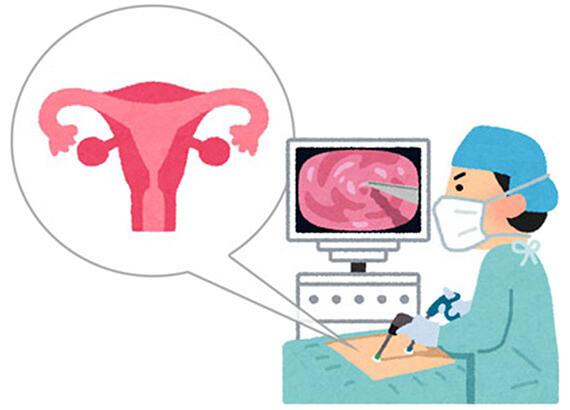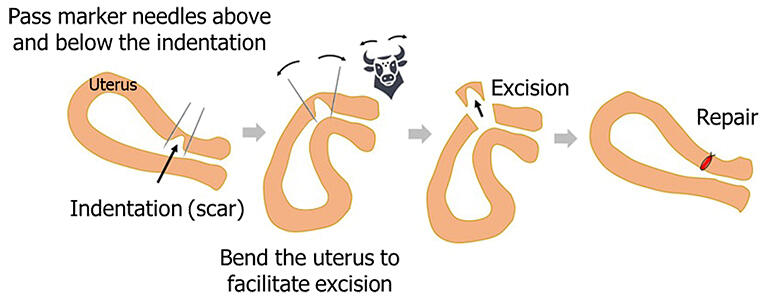A research group at St. Luke's International Hospital has developed a new surgical technique to remove "indentations" that form inside the uterus after cesarean section surgery. These indentations can cause complications such as infertility and abnormal bleeding, and this serves as a treatment method. Two needles are inserted from the abdominal side into the uterus like bull's horns to serve as guides (landmarks), and only the indented areas are removed through laparoscopic surgery. The technique was named the "Taurus T Method" after the shape of the needles, referring to the constellation Taurus.
A cesarean section is a surgical procedure that has been performed since ancient times during childbirth, in cases where the baby is in distress, or when there are multiple pregnancies or breech presentations. According to the Ministry of Health, Labour and Welfare, the proportion of cesarean sections among all deliveries in general hospitals was 29.1 percent in 2023, showing an increasing trend year by year.
In recent years, cases have been identified where subsequent pregnancies have been unsuccessful even after receiving fertility treatment following cesarean delivery. Additionally, many patients suffer from complications such as persistent abnormal bleeding and severe menstrual pain after a cesarean section. These patients have indentations near the cervix. Blood and other substances tend to accumulate in these indentations, and physical factors are believed to affect subsequent pregnancies.
The various symptoms caused by these indentations are called "cesarean scar disorder," and surgery to address this condition became covered by insurance in 2022. However, accurately removing indentations that cannot be seen from outside the uterus and suturing them cleanly is a difficult surgery, resulting in remarkably few procedures being performed. Moreover, why these indentations form is not yet understood.

The group, led by Dr. Tetsuya Hirata, a specialist in reproductive endocrinology and Director of the Department of Integrated Women's Health at St. Luke's International Hospital, has been researching whether surgery for cesarean scar disorder could be performed more easily and along accurate guides. Uterine indentations can only be observed from inside the uterus, yet these indentations need to be accurately excised from outside the uterus.
In previous research, the group established a method of performing hysteroscopy (endoscopic examination), which is normally done by filling the uterine cavity with saline solution, without using water, allowing simultaneous hysteroscopy and laparoscopy to accurately excise the indented areas with laparoscopy.
This time, they developed a marking technique to be more accurate and avoid removing excess tissue. Two needles are inserted from the abdominal side at the lesion sites observed by hysteroscopy, and light is shone on the indentation locations identified by hysteroscopy to make them visible from outside the uterus (laparoscopy). Next, the entire uterus is bent to angle the needles, thereby stabilizing the soft uterus. Using these needles as landmarks, a T-shaped incision is made, the areas with uterine indentations are cleanly removed, and then sutured.
This surgical technique was named the "Taurus T Method," derived from "Taurus" (the constellation Taurus), based on how the two needles open at an angle through the bending of the uterus.

Provided by Director Tetsuya Hirata
This was applied to actual clinical cases after cesarean section surgery: a 41-year-old woman who came to the hospital with persistent abnormal bleeding as her chief complaint stopped bleeding after the procedure. A 35-year-old woman who came with infertility as her chief complaint, having failed to conceive despite four in vitro fertilization attempts, achieved pregnancy after the surgery. It is reported that 50-70% of women who undergo this surgery are able to have subsequent deliveries. The Taurus T Method also has the advantage of making it easy to submit tissue for pathological examination after removal.
Hirata stated, "Since increasing pregnancy rates is also a goal, we want to continue observing post-surgical progress." He added, "This cesarean scar disorder is one of the 'iatrogenic diseases' caused by medical treatment. We want to investigate the 'predisposition situations,' such as what types of cesarean sections are more likely to cause this—for example, whether it's a scheduled surgery or emergency operation, and under what cervical conditions this occurs." It is reported that obstetricians and gynecologists from across the country visit St. Luke's International Hospital to observe the Taurus T Method.
The results were published in the electronic edition of the American Society for Reproductive Medicine journal Fertility and Sterility on March 28, and announced by St. Luke's International University on April 15.
Original article was provided by the Science Portal and has been translated by Science Japan.




